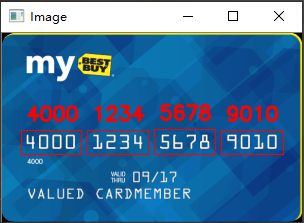myutils.py:
import cv2 def sort_contours(cnts, method="left-to-right"): reverse = False i = 0 if method == "right-to-left" or method == "bottom-to-top": reverse = True if method == "top-to-bottom" or method == "bottom-to-top": i = 1 boundingBoxes = [cv2.boundingRect(c) for c in cnts] #用一个最小的矩形,把找到的形状包起来x,y,h,w (cnts, boundingBoxes) = zip(*sorted(zip(cnts, boundingBoxes), key=lambda b: b[1][i], reverse=reverse)) return cnts, boundingBoxes def resize(image, width=None, height=None, inter=cv2.INTER_AREA): dim = None (h, w) = image.shape[:2] if width is None and height is None: return image if width is None: r = height / float(h) dim = (int(w * r), height) else: r = width / float(w) dim = (width, int(h * r)) resized = cv2.resize(image, dim, interpolation=inter) return resized
ocr_template_match.py:
# 导入工具包 from imutils import contours import numpy as np import argparse import cv2 import myutils # 设置参数 ap = argparse.ArgumentParser() ap.add_argument("-i", "--image", required=True, help="path to input image") ap.add_argument("-t", "--template", required=True, help="path to template OCR-A image") args = vars(ap.parse_args()) # 指定信用卡类型 FIRST_NUMBER = { "3": "American Express", "4": "Visa", "5": "MasterCard", "6": "Discover Card" } # 绘图展示 def cv_show(name,img): cv2.imshow(name, img) cv2.waitKey(0) cv2.destroyAllWindows() # 读取一个模板图像 img = cv2.imread(args["template"]) cv_show('img',img) # 灰度图 ref = cv2.cvtColor(img, cv2.COLOR_BGR2GRAY) cv_show('ref',ref) # 二值图像 ref = cv2.threshold(ref, 10, 255, cv2.THRESH_BINARY_INV)[1] cv_show('ref',ref) # 计算轮廓 #cv2.findContours()函数接受的参数为二值图,即黑白的(不是灰度图),cv2.RETR_EXTERNAL只检测外轮廓,cv2.CHAIN_APPROX_SIMPLE只保留终点坐标 #返回的list中每个元素都是图像中的一个轮廓 ref_, refCnts, hierarchy = cv2.findContours(ref.copy(), cv2.RETR_EXTERNAL,cv2.CHAIN_APPROX_SIMPLE) cv2.drawContours(img,refCnts,-1,(0,0,255),3) cv_show('img',img) print (np.array(refCnts).shape) refCnts = myutils.sort_contours(refCnts, method="left-to-right")[0] #排序,从左到右,从上到下 digits = {} # 遍历每一个轮廓 for (i, c) in enumerate(refCnts): # 计算外接矩形并且resize成合适大小 (x, y, w, h) = cv2.boundingRect(c) roi = ref[y:y + h, x:x + w] roi = cv2.resize(roi, (57, 88)) # 每一个数字对应每一个模板 digits[i] = roi # 初始化卷积核 rectKernel = cv2.getStructuringElement(cv2.MORPH_RECT, (9, 3)) sqKernel = cv2.getStructuringElement(cv2.MORPH_RECT, (5, 5)) #读取输入图像,预处理 image = cv2.imread(args["image"]) cv_show('image',image) image = myutils.resize(image, width=300) gray = cv2.cvtColor(image, cv2.COLOR_BGR2GRAY) cv_show('gray',gray) #礼帽操作,突出更明亮的区域 tophat = cv2.morphologyEx(gray, cv2.MORPH_TOPHAT, rectKernel) cv_show('tophat',tophat) # gradX = cv2.Sobel(tophat, ddepth=cv2.CV_32F, dx=1, dy=0, #ksize=-1相当于用3*3的 ksize=-1) gradX = np.absolute(gradX) (minVal, maxVal) = (np.min(gradX), np.max(gradX)) gradX = (255 * ((gradX - minVal) / (maxVal - minVal))) gradX = gradX.astype("uint8") print (np.array(gradX).shape) cv_show('gradX',gradX) #通过闭操作(先膨胀,再腐蚀)将数字连在一起 gradX = cv2.morphologyEx(gradX, cv2.MORPH_CLOSE, rectKernel) cv_show('gradX',gradX) #THRESH_OTSU会自动寻找合适的阈值,适合双峰,需把阈值参数设置为0 thresh = cv2.threshold(gradX, 0, 255, cv2.THRESH_BINARY | cv2.THRESH_OTSU)[1] cv_show('thresh',thresh) #再来一个闭操作 thresh = cv2.morphologyEx(thresh, cv2.MORPH_CLOSE, sqKernel) #再来一个闭操作 cv_show('thresh',thresh) # 计算轮廓 thresh_, threshCnts, hierarchy = cv2.findContours(thresh.copy(), cv2.RETR_EXTERNAL, cv2.CHAIN_APPROX_SIMPLE) cnts = threshCnts cur_img = image.copy() cv2.drawContours(cur_img,cnts,-1,(0,0,255),3) cv_show('img',cur_img) locs = [] # 遍历轮廓 for (i, c) in enumerate(cnts): # 计算矩形 (x, y, w, h) = cv2.boundingRect(c) ar = w / float(h) # 选择合适的区域,根据实际任务来,这里的基本都是四个数字一组 if ar > 2.5 and ar < 4.0: if (w > 40 and w < 55) and (h > 10 and h < 20): #符合的留下来 locs.append((x, y, w, h)) # 将符合的轮廓从左到右排序 locs = sorted(locs, key=lambda x:x[0]) output = [] # 遍历每一个轮廓中的数字 for (i, (gX, gY, gW, gH)) in enumerate(locs): # initialize the list of group digits groupOutput = [] # 根据坐标提取每一个组 group = gray[gY - 5:gY + gH + 5, gX - 5:gX + gW + 5] cv_show('group',group) # 预处理 group = cv2.threshold(group, 0, 255, cv2.THRESH_BINARY | cv2.THRESH_OTSU)[1] cv_show('group',group) # 计算每一组的轮廓 group_,digitCnts,hierarchy = cv2.findContours(group.copy(), cv2.RETR_EXTERNAL, cv2.CHAIN_APPROX_SIMPLE) digitCnts = contours.sort_contours(digitCnts, method="left-to-right")[0] # 计算每一组中的每一个数值 for c in digitCnts: # 找到当前数值的轮廓,resize成合适的的大小 (x, y, w, h) = cv2.boundingRect(c) roi = group[y:y + h, x:x + w] roi = cv2.resize(roi, (57, 88)) cv_show('roi',roi) # 计算匹配得分 scores = [] # 在模板中计算每一个得分 for (digit, digitROI) in digits.items(): # 模板匹配 result = cv2.matchTemplate(roi, digitROI, cv2.TM_CCOEFF) (_, score, _, _) = cv2.minMaxLoc(result) scores.append(score) # 得到最合适的数字 groupOutput.append(str(np.argmax(scores))) # 画出来 cv2.rectangle(image, (gX - 5, gY - 5), (gX + gW + 5, gY + gH + 5), (0, 0, 255), 1) cv2.putText(image, "".join(groupOutput), (gX, gY - 15), cv2.FONT_HERSHEY_SIMPLEX, 0.65, (0, 0, 255), 2) # 得到结果 output.extend(groupOutput) # 打印结果 print("Credit Card Type: {}".format(FIRST_NUMBER[output[0]])) print("Credit Card #: {}".format("".join(output))) cv2.imshow("Image", image) cv2.waitKey(0)
效果:
(10,) (189, 300) Credit Card Type: Visa Credit Card #: 4000123456789010
